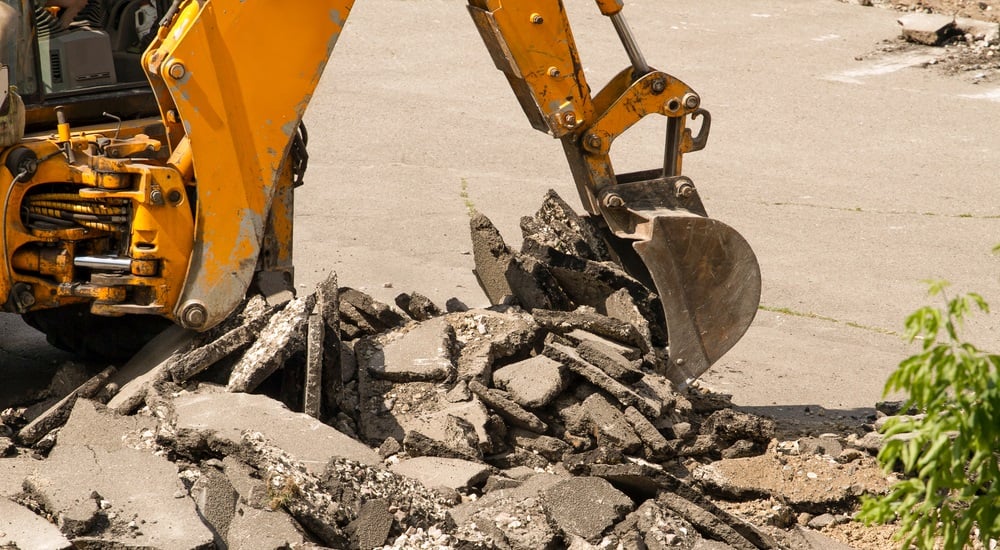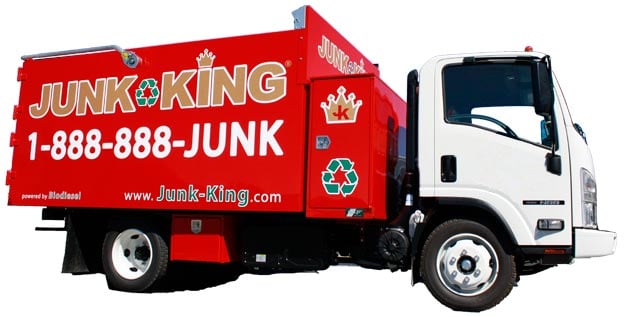
[This article was originally published in March 2020 and has been revised and expanded.]
If you're engaged in a major construction project with demolition, odds are you'll end up with concrete, masonry and asphalt debris. So, what do you do with it?
Whether you are doing demolition, remodeling, or construction, there is always the time sensitive and costly process of getting rid of leftover debris. Concrete disposal, in particular, can be challenging.
Demolition Can Add Concrete Debris to Construction Waste
When it comes to demolition, the variety and volume of debris can be overwhelming. Materials such as wood, steel, tiling and drywall can all be extremely difficult to haul off of a construction site.
But concrete is probably the worst.
Concrete, asphalt and masonry is bulky, heavy, and takes up large amounts of space in a truck. Not to mention that it can be difficult to dispose of. The good news is that this material does not need to end up in our landfills.
To anyone working on a construction site - whether a small, residential job or a large, commercial project - dealing with large amounts of debris and waste generated can be challenging.
So, how much of this construction and demolition or C&D waste do we create in the US?
According to the Environmental Protection Agency (EPA), it is estimated that anywhere between 230 million to 600 million tons of C&D waste are produced nationwide each year in the United States. This adds up to more than twice the amount of annual generated municipal solid waste in the U.S. Also, more than 90 percent of C&D debris comes from demolition projects, while new construction accounts for less than 10 percent.
Oh, and concrete makes up a large portion of that waste. In fact, in 2015, for example, concrete accounted for 23.1 million tons of waste during construction and a total of 358.7 million tons of demolition debris, according to the EPA.
Fortunately for contractors, the economy and the environment, technology has improved the ability to recycle and reuse concrete, masonry, asphalt and similar materials. The result of these advances is that we now have a wide variety of options for constructively disposing of concrete in environmentally friendly ways.
In fact, the Federal Highway Agency (FHWA) has determined that is possible to recycle between 90 and 100 percent of reclaimed asphalt pavement.

How Concrete Disposal for Recycling Helps the Planet
Construction and demolition (C&D) waste makes up a significant amount of the overall waste generated in the United States each year. According to the EPA's 2017 Fact Sheet,
- 569 million tons of C&D debris were generated in the United States in 2017, which is more than twice the amount of generated municipal solid waste.
- Demolition represents more than 90 percent of total C&D debris generation, while construction represents less than 10 percent.
This volume represents more than double the amount of municipal solid waste, or MSW, generated in the same year. And the largest amount of C&D material is concrete, which makes up about 70 percent of C&D generated material, according to the EPA.
The good news is that over 140 million tons of concrete are recycled annually, according to the Construction & Demolition Recycling Association.
So, what happens to all that recycled material?
Wikipedia notes that,
"Concrete aggregate collected from demolition sites is put through a crushing machine. Crushing facilities accept only uncontaminated concrete, which must be free of trash, wood, paper and other such materials. Metals such as rebar are accepted, since they can be removed with magnets and other sorting devices and melted down for recycling elsewhere. The remaining aggregate chunks are sorted by size. Larger chunks may go through the crusher again. After crushing has taken place, other particulates are filtered out through a variety of methods including hand-picking and water flotation."
Larger construction companies sometimes maintain portable concrete rubble crushing machinery on-site, which reduces construction costs and the pollution generated from transporting concrete material to a concrete recycling facility.
Some of the large road-portable plants can crush concrete and asphalt rubble at 600 tons per hour or more. And there are also more compact, self-contained mini-crushers that can handle up to 150 tons per hour and fit into smaller sites.
Wikipedia also noted that, with the advent of crusher attachments that can connect to construction equipment like excavators, the trend towards recycling on-site with smaller volumes of material is growing rapidly.

"North America dominated the recycled concrete aggregates market and accounted for the greatest revenue share of around 41% in 2022 as a result of the rising demand for recycled concrete aggregates as a sustainable source throughout the region. "
The same report goes on to note that the market for recycled concrete products has experienced an increase in the number of developing enterprises and new market entries due to the nature of the sector and the lack of unduly demanding technical and capital requirements.
Here are five of the most common uses for the waste concrete produced in the U.S. each year:
1. Road Building Material
Smaller pieces of concrete are regularly used as gravel for new road construction projects. Sub-base gravel is laid down as the lowest layer in a road, with fresh concrete or asphalt poured over it. In addition, concrete pavements can be broken in place and used as a base layer for an asphalt pavement through a process called rubblization.
2. Concrete Aggregate
Concrete disposal can end up as crushed recycled concrete which can also be used as the dry aggregate for brand new concrete if it is free of contaminants. The California Department of transportation (Caltrans), for example, allows the use of recycled concrete aggregate, or RCA, for specific applications.
3. Riprap Material
Larger pieces of crushed concrete can be used as riprap revetments, which has become an effective and well-used method for controlling stream bank erosion.This material can be seen along the shoreline, around ditch pipe, and in much landscaping.
4. Landscaping Materials
Some crushing facilities can produce well-graded and aesthetically pleasing materials that are used as substitutes for landscaping stone or aggregate. One type of reused concrete material is known as “urbanite” and can be used for constructing benches, garden walls, rockeries, raised beds, foundations for terraces, as well as paths and patios.
5. Gabion Filler
Wire gabions, or cages, can be filled with crushed concrete and then stacked together to provide economical retaining walls. These gabions can also be used to protect embankments or other structures. In such cases even bigger sizes of the crushed and recycled concrete can be used. These gabions function well because of their weight and density.
Concrete waste disposal can be one of the tougher debris removal tasks for a contractor. Fortunately, licensed and professional hauling firms such as Junk King are available to handle this type of construction debris.
Aside from the economic, logistical, and efficiency benefits of outsourcing concrete waste disposal, there are the green benefits, as well.
Once your concrete waste and debris has been cleaned up and removed from your job site it doesn't simply get hauled off to the nearest landfill. In fact, whenever possible, the concrete waste is recycled and reused in a number of ways.
Part of the beauty of outsourcing the pick up and disposing of your construction concrete waste is the convenience. But, just as important, is the very real impact that having your concrete debris recycled and reused.
Get the Best Construction Waste Removal
Junk King provides efficient, safe and eco-friendly construction waste removal service so you don’t need to worry about the pick up and disposal of the debris once your project is complete. Whether you need our services several times during a construction project or just once after it is complete, our hauling professionals will ensure that the construction debris is out of your way so that you can get on with the job.
Our team specializes in construction debris removal. We can be at your facility in mere minutes and our crew is fully insured and well-trained, so you can trust them to get rid of your construction debris in a professional and courteous fashion.
So, are you ready to have us come on the site for your construction waste removal?
Make an appointment simply by booking online above or by calling us at 1-888-888-JUNK (5865) and our professional and insured hauling team will go to your site. We'll call 15 to 30 minutes before we arrive and we’ll give you a free estimate based on how much room your debris takes up in our truck.
We load the construction waste into our junk removal trucks and haul it away with no hidden fees.






